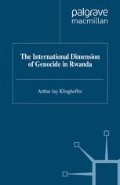Abstract
Rwanda’s political system, based upon ethnic stratification, was targeted for destruction by the large Tutsi diaspora living in neighboring states. This combustible situation was then inflamed by an invasion of Banyarwanda Tutsi from Uganda, which in turn engendered external intervention in support of the Habyarimana government. An intractable civil war then produced almost one million more refugees by early 1993, and it later served to mask the emerging genocide.1 Sovereignty fell by the wayside as regional ethnic dynamics gained precedence.
Access this chapter
Tax calculation will be finalised at checkout
Purchases are for personal use only
Preview
Unable to display preview. Download preview PDF.
Notes
See Jason Clay, ‘The Eviction of Banyaruanda’ ( Cambridge, MA: Cultural Survival, August 1984 ), p. 16
Jason Clay, ‘Uganda and Sudan’ ( London: The Minority Rights Group, December 1984 ), p. 10.
Clay, pp. 1–3, 8 and 29–31; ‘Rwanda: Who is Killing; Who is Dying; What is to be Done’ (London: African Rights, May 1994), p. 8; Wm. Cyrus Reed, ‘The Rwandan Patriotic Front: Politics and Development in Rwanda,’ Issue, vol. XXIII, no. 2 (1995): 49; and The New York Times January 21, 1983, p. A2 and December 18, 1983, p. 5.
Gerard Prunier, The Rwanda Crisis, 1959–1994: History of a Genocide ( London: Hurst and Co., 1995 ), pp. 69–70
Martin Plant, ‘Rwanda: Looking Beyond the Slaughter,’ The World Today, vol. 50, nos. 8–9 (August-September 1994): 151
and Arming Rwanda: The Arms Trade and Human Rights Abuses in the Rwandan War’ (New York: Human Rights Watch Arms Project, January 1994), p. 8. Museveni may also have had ties to Tutsi in Burundi. It has been claimed that the Burundian cotton board provided him with $8 million for uniforms prior to his successful overthrow of Obote. See James MacGuire, ‘Rwanda Before the Massacre,’ Media Critic, vol. 2, no. 1 (Fall 1994 ): 42.
Rwanda’ in Francois Jean, ed., Populations in Danger 1995 (London: Médecins Sans Frontières, 1995), p. 34; Reed, p. 49;
and Bruce Jones, “Intervention Without Borders’: Humanitarian Intervention in Rwanda, 1990–94,’ Millenium, vol. 24, no. 2 (Summer 1995): 227.
Rakiya Omaar and Alex de Waal, Rwanda: Death, Despair and Defiance (London: African Rights, 1994), p. 62; Dixon Kamukama, ‘Rwanda Conflict’ (Kampala: Fountain Publishers, 1993), p. 40; and Prunier, pp. 68 and 70.
Frank Smyth, ‘Arms for Rwanda: Blood Money and Geopolitics,’ The Nation, vol. 258, no. 17 (May 2, 1994): 586–87
and Stephen Goose and Frank Smyth, ‘Arming Genocide in Rwanda,’ Foreign Affairs, vol. 73, no. 5 (September-October 1994): 88–89.
Omaar and de Waal, p. 38 and Alex de Waal, ‘The Genocidal State,’ Times Literary Supplement, no. 4761 (July 1, 1994): 3.
Prunier, pp. 100 and 110–11; Paris, AFP in English, October 4, 1990 (FBIS-WEU-90–194); Paris, AFP in English, October 4, 1990 (FBISWEU-90–194); Paris AFP in English, October 3, 1990 (FBIS-AFR-90193); Brussels Domestic Service in French, October 3, 1990 (FBISWEU-90–193); ‘Rwanda: Talking Peace and Waging War,’ p. 29; Paris, AFP in English, October 5, 1990 (FBIS-WEU-90–195); Keesing’s, 1990, p. 37766; Paris, AFP in English, October 7, 1990 (FBIS-AFR-90–195); and Filip Reyntjens, L’Afrique Des Grands Lacs En Crise ( Paris: Karthala, 1994 ), p. 177.
Tor Sellstrom and Lennart Wohlgemuth, ‘Historical Perspective: Some Explanatory Factors,’ in The International Response to Conflict and Genocide: Lessons from the Rwanda Experience, vol. I (Copenhagen: Steering Committee of the Joint Evaluation of Emergency Assistance to Rwanda, March 1996), p. 42; West Africa October 22–28, 1990, p. 2715; and Keesing’s 1990, p. 37766.
Jean-Claude Willame, ‘La Belgique et Le ‘Muyaga’ Des Grands Lacs,’ in Andre Guichaoua, ed., Les crises politiques au Burundi et au Rwanda (1993–1994) ( Lille: Université Des Sciences et Technologies, 1995 ), p. 437.
Author information
Authors and Affiliations
Copyright information
© 1998 Arthur Jay Klinghoffer
About this chapter
Cite this chapter
Klinghoffer, A.J. (1998). Return From Exile. In: The International Dimension of Genocide in Rwanda. Palgrave Macmillan, London. https://doi.org/10.1057/9780230375062_3
Download citation
DOI: https://doi.org/10.1057/9780230375062_3
Publisher Name: Palgrave Macmillan, London
Print ISBN: 978-1-349-40683-8
Online ISBN: 978-0-230-37506-2
eBook Packages: Palgrave Political & Intern. Studies CollectionPolitical Science and International Studies (R0)

